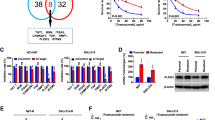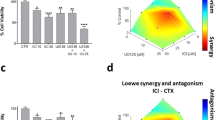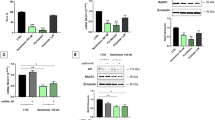Abstract
Currently, trastuzumab resistance is a major clinical problem in the treatment of Her2-overexpressing breast cancer. The underlying molecular mechanisms are not fully understood. Our previous study demonstrates that β2-adrenergic receptor (β2-AR) and Her2 comprise a positive feedback loop in human breast cancer cells and that crosstalk between Her2 and β2-AR affects the bio-behaviors of breast cancer cells, suggesting that the β2-AR activation may be involved in trastuzumab resistance. In this study, we show that the expression of β2-AR, which mediates most catecholamine-induced effects, negatively correlates with trastuzumab response in the patients with Her2-overexpressing breast cancer. Catecholamines potently antagonize the anti-proliferative effects of trastuzumab both in vitro and in vivo. Catecholamine stimulation upregulates the expression of miR-21 and MUC-1 by activating Her2 and STAT3, leading to deficiency of phosphatase and tensin homolog and activation of phosphatidylinositol-3-kinase (PI3K) and Akt. Through inhibition of miR-199a/b-3p, catecholamines induce the mammalian target of rapamycin (mTOR) activation. Thus, trastuzumab resistance-dependent PI3K/Akt/mTOR pathway is controlled by catecholamine-induced β2-AR activation. The data indicate that β2-AR is a reliable molecular marker for prediction of response probability to trastuzumab-based therapy in breast cancer. We also demonstrate that β-blocker propranolol not only enhances the antitumor activities of trastuzumab but also re-sensitizes the resistant cells to trastuzumab. Our retrospective study shows that concurrent treatment of β-blocker and trastuzumab significantly improved progression-free survival and overall survival in the patients with Her2-overexpressing metastatic breast cancer, implicating the possibility for combination therapy with trastuzumab plus β-blocker in Her2-overexpressing breast cancer.
This is a preview of subscription content, access via your institution
Access options
Subscribe to this journal
Receive 50 print issues and online access
$259.00 per year
only $5.18 per issue
Buy this article
- Purchase on Springer Link
- Instant access to full article PDF
Prices may be subject to local taxes which are calculated during checkout







Similar content being viewed by others
References
Romond EH, Perez EA, Bryant J, Suman VJ, Geyer CE Jr, Davidson NE et al. Trastuzumab plus adjuvant chemotherapy for operable HER2-positive breast cancer. N Engl J Med 2005; 353: 1673–1684.
Seidman AD, Berry D, Cirrincione C, Harris L, Muss H, Marcom PK et al. Randomized phase III trial of weekly compared with every-3-weeks paclitaxel for metastatic breast cancer, with trastuzumab for all HER-2 overexpressors and random assignment to trastuzumab or not in HER-2 nonoverexpressors: final results of Cancer and Leukemia Group B protocol 9840. J Clin Oncol 2008; 26: 1642–1649.
Arteaga CL, Sliwkowski MX, Osborne CK, Perez EA, Puglisi F, Gianni L . Treatment of HER2-positive breast cancer: current status and future perspectives. Nat Rev Clin Oncol 2012; 9: 16–32.
Stern HM . Improving treatment of HER2-positive cancers: opportunities and challenges. Sci Transl Med 2012; 4: 127rv122.
Mukohara T . Mechanisms of resistance to anti-human epidermal growth factor receptor 2 agents in breast cancer. Cancer Sci 2011; 102: 1–8.
Park BH, Davidson NE . PI3 kinase activation and response to trastuzumab therapy: what's neu with herceptin resistance? Cancer Cell 2007; 12: 297–299.
Gijsen M, King P, Perera T, Parker PJ, Harris AL, Larijani B et al. HER2 phosphorylation is maintained by a PKB negative feedback loop in response to anti-HER2 herceptin in breast cancer. PLoS Biol 2010; 8: e1000563.
Zhang S, Huang WC, Li P, Guo H, Poh SB, Brady SW et al. Combating trastuzumab resistance by targeting SRC, a common node downstream of multiple resistance pathways. Nat Med 2011; 17: 461–469.
Liang K, Esteva FJ, Albarracin C, Stemke-Hale K, Lu Y, Bianchini G et al. Recombinant human erythropoietin antagonizes trastuzumab treatment of breast cancer cells via Jak2-mediated Src activation and PTEN inactivation. Cancer Cell 2010; 18: 423–435.
Nagata Y, Lan KH, Zhou X, Tan M, Esteva FJ, Sahin AA et al. PTEN activation contributes to tumor inhibition by trastuzumab, and loss of PTEN predicts trastuzumab resistance in patients. Cancer Cell 2004; 6: 117–127.
Korkaya H, Kim GI, Davis A, Malik F, Henry NL, Ithimakin S et al. Activation of an IL6 inflammatory loop mediates trastuzumab resistance in HER2+ breast cancer by expanding the cancer stem cell population. Mol Cell 2012; 47: 570–584.
Berns K, Horlings HM, Hennessy BT, Madiredjo M, Hijmans EM, Beelen K et al. A functional genetic approach identifies the PI3K pathway as a major determinant of trastuzumab resistance in breast cancer. Cancer Cell 2007; 12: 395–402.
Cole SW, Sood AK . Molecular pathways: beta-adrenergic signaling in cancer. Clin Cancer Res 2012; 18: 1201–1206.
Shi M, Liu D, Yang Z, Guo N . Central and peripheral nervous systems: master controllers in cancer metastasis. Cancer Metastasis Rev 2013; 32: 603–621.
Magnon C, Hall SJ, Lin J, Xue X, Gerber L, Freedland SJ et al. Autonomic nerve development contributes to prostate cancer progression. Science (New York, NY) 2013; 341: 1236361.
Lutgendorf SK, DeGeest K, Sung CY, Arevalo JM, Penedo F, Lucci J 3rd et al. Depression, social support, and beta-adrenergic transcription control in human ovarian cancer. Brain Behav Immun 2009; 23: 176–183.
Lutgendorf SK, Sood AK, Antoni MH . Host factors and cancer progression: biobehavioral signaling pathways and interventions. J Clin Oncol 2010; 28: 4094–4099.
Sloan EK, Priceman SJ, Cox BF, Yu S, Pimentel MA, Tangkanangnukul V et al. The sympathetic nervous system induces a metastatic switch in primary breast cancer. Cancer Res 2010; 70: 7042–7052.
Campbell JP, Karolak MR, Ma Y, Perrien DS, Masood-Campbell SK, Penner NL et al. Stimulation of host bone marrow stromal cells by sympathetic nerves promotes breast cancer bone metastasis in mice. PLoS Biol 2012; 10: e1001363.
Armaiz-Pena GN, Allen JK, Cruz A, Stone RL, Nick AM, Lin YG et al. Src activation by beta-adrenoreceptors is a key switch for tumour metastasis. Nat Commun 2013; 4: 1403.
Hassan S, Karpova Y, Baiz D, Yancey D, Pullikuth A, Flores A et al. Behavioral stress accelerates prostate cancer development in mice. J Clin Invest 2013; 123: 874–886.
Shi M, Liu D, Duan H, Qian L, Wang L, Niu L et al. The beta2-adrenergic receptor and Her2 comprise a positive feedback loop in human breast cancer cells. Breast Cancer Res Treat 2011; 125: 351–362.
Esteva FJ, Wang J, Lin F, Mejia JA, Yan K, Altundag K et al. CD40 signaling predicts response to preoperative trastuzumab and concomitant paclitaxel followed by 5-fluorouracil, epirubicin, and cyclophosphamide in HER-2-overexpressing breast cancer. Breast Cancer Res 2007; 9: R87.
Arnould L, Arveux P, Couturier J, Gelly-Marty M, Loustalot C, Ettore F et al. Pathologic complete response to trastuzumab-based neoadjuvant therapy is related to the level of HER-2 amplification. Clin Cancer Res 2007; 13: 6404–6409.
Dominici LS, Negron Gonzalez VM, Buzdar AU, Lucci A, Mittendorf EA, Le-Petross HT et al. Cytologically proven axillary lymph node metastases are eradicated in patients receiving preoperative chemotherapy with concurrent trastuzumab for HER2-positive breast cancer. Cancer 2010; 116: 2884–2889.
Spector NL, Blackwell KL . Understanding the mechanisms behind trastuzumab therapy for human epidermal growth factor receptor 2-positive breast cancer. J Clin Oncol 2009; 27: 5838–5847.
Shi M, Zhao M, Hu M, Liu D, Cao H, Qian L et al. Beta2-AR-induced Her2 transactivation mediated by Erbin confers protection from apoptosis in cardiomyocytes. Int J Cardiol 2012; 167: 1570–7.
Gong C, Yao Y, Wang Y, Liu B, Wu W, Chen J et al. Up-regulation of miR-21 mediates resistance to trastuzumab therapy for breast cancer. J Biol Chem 2011; 286: 19127–19137.
Meng F, Henson R, Wehbe-Janek H, Ghoshal K, Jacob ST, Patel T . MicroRNA-21 regulates expression of the PTEN tumor suppressor gene in human hepatocellular cancer. Gastroenterology 2007; 133: 647–658.
Huang TH, Wu F, Loeb GB, Hsu R, Heidersbach A, Brincat A et al. Up-regulation of miR-21 by HER2/neu signaling promotes cell invasion. J Biol Chem 2009; 284: 18515–18524.
Iliopoulos D, Jaeger SA, Hirsch HA, Bulyk ML, Struhl K . STAT3 activation of miR-21 and miR-181b-1 via PTEN and CYLD are part of the epigenetic switch linking inflammation to cancer. Mol Cell 2010; 39: 493–506.
Garcia-Garcia C, Ibrahim YH, Serra V, Calvo MT, Guzman M, Grueso J et al. Dual mTORC1/2 and HER2 Blockade Results in Antitumor Activity in Preclinical Models of Breast Cancer Resistant to Anti-HER2 Therapy. Clin Cancer Res 2012; 18: 2603–2612.
Morrow PK, Wulf GM, Ensor J, Booser DJ, Moore JA, Flores PR et al. Phase I/II study of trastuzumab in combination with everolimus (RAD001) in patients with HER2-overexpressing metastatic breast cancer who progressed on trastuzumab-based therapy. J Clin Oncol 2011; 29: 3126–3132.
Fornari F, Milazzo M, Chieco P, Negrini M, Calin GA, Grazi GL et al. MiR-199a-3p regulates mTOR and c-Met to influence the doxorubicin sensitivity of human hepatocarcinoma cells. Cancer Res 2010; 70: 5184–5193.
Hou J, Lin L, Zhou W, Wang Z, Ding G, Dong Q et al. Identification of miRNomes in human liver and hepatocellular carcinoma reveals miR-199a/b-3p as therapeutic target for hepatocellular carcinoma. Cancer Cell 2011; 19: 232–243.
Fessler SP, Wotkowicz MT, Mahanta SK, Bamdad C . MUC1* is a determinant of trastuzumab (Herceptin) resistance in breast cancer cells. Breast Cancer Res Treat 2009; 118: 113–124.
Macao B, Johansson DG, Hansson GC, Hard T . Autoproteolysis coupled to protein folding in the SEA domain of the membrane-bound MUC1 mucin. Nat Struct Mol Biol 2006; 13: 71–76.
Woo JK, Choi Y, Oh SH, Jeong JH, Choi DH, Seo HS et al. Mucin 1 enhances the tumor angiogenic response by activation of the AKT signaling pathway. Oncogene 2012; 31: 2187–2198.
Yao M, Zhang W, Zhang Q, Xing L, Xu A, Liu Q et al. Overexpression of MUC1 enhances proangiogenic activity of non-small-cell lung cancer cells through activation of Akt and extracellular signal-regulated kinase pathways. Lung 2011; 189: 453–460.
Ahmad R, Rajabi H, Kosugi M, Joshi MD, Alam M, Vasir B et al. MUC1-C oncoprotein promotes STAT3 activation in an autoinductive regulatory loop. Sci Signal 2011; 4: ra9.
Xiao RP . Beta-adrenergic signaling in the heart: dual coupling of the beta2-adrenergic receptor to G(s) and G(i) proteins. Sci STKE 2001; 2001: re15.
Hara MR, Kovacs JJ, Whalen EJ, Rajagopal S, Strachan RT, Grant W et al. A stress response pathway regulates DNA damage through beta2-adrenoreceptors and beta-arrestin-1. Nature 2011; 477: 349–353.
Barron TI, Connolly RM, Sharp L, Bennett K, Visvanathan K . Beta blockers and breast cancer mortality: a population- based study. J Clin Oncol 2011; 29: 2635–2644.
Melhem-Bertrandt A, Chavez-Macgregor M, Lei X, Brown EN, Lee RT, Meric-Bernstam F et al. Beta-blocker use is associated with improved relapse-free survival in patients with triple-negative breast cancer. J Clin Oncol 2011; 29: 2645–2652.
Ganz PA, Cole SW . Expanding our therapeutic options: beta blockers for breast cancer? J Clin Oncol 2011; 29: 2612–2616.
Carbajal L, Biswas A, Niswander LM, Prizant H, Hammes SR . GPCR/EGFR cross talk is conserved in gonadal and adrenal steroidogenesis but is uniquely regulated by matrix metalloproteinases 2 and 9 in the ovary. Mol Endocrinol (Baltimore, MD) 2011; 25: 1055–1065.
Lappano R, Maggiolini M . G protein-coupled receptors: novel targets for drug discovery in cancer. Nat Rev Drug Discov 2011; 10: 47–60.
Kuzumaki N, Suzuki A, Narita M, Hosoya T, Nagasawa A, Imai S et al. Multiple analyses of G-protein coupled receptor (GPCR) expression in the development of gefitinib-resistance in transforming non-small-cell lung cancer. PLoS One 2012; 7: e44368.
Bhola NE, Thomas SM, Freilino M, Joyce S, Sahu A, Maxwell J et al. Targeting GPCR-mediated p70S6K activity may improve head and neck cancer response to cetuximab. Clin Cancer Res 2011; 17: 4996–5004.
Gu L, Lau SK, Loera S, Somlo G, Kane SE . Protein kinase A activation confers resistance to trastuzumab in human breast cancer cell lines. Clin Cancer Res 2009; 15: 7196–7206.
Garcia-Recio S, Fuster G, Fernandez-Nogueira P, Pastor-Arroyo EM, Park SY, Mayordomo C et al. Substance P autocrine signaling contributes to persistent HER2 activation that drives malignant progression and drug resistance in breast cancer. Cancer Res 2013; 73: 6424–6434.
Haghikia A, Missol-Kolka E, Tsikas D, Venturini L, Brundiers S, Castoldi M et al. Signal transducer and activator of transcription 3-mediated regulation of miR-199a-5p links cardiomyocyte and endothelial cell function in the heart: a key role for ubiquitin-conjugating enzymes. Eur Heart J 2011; 32: 1287–1297.
Dave B, Migliaccio I, Gutierrez MC, Wu MF, Chamness GC, Wong H et al. Loss of phosphatase and tensin homolog or phosphoinositol-3 kinase activation and response to trastuzumab or lapatinib in human epidermal growth factor receptor 2-overexpressing locally advanced breast cancers. J Clin Oncol 2011; 29: 166–173.
Powe DG, Entschladen F . Targeted therapies: using beta-blockers to inhibit breast cancer progression. Nat Rev Clin Oncol 2011; 8: 511–512.
Sorensen GV, Ganz PA, Cole SW, Pedersen LA, Sorensen HT, Cronin-Fenton DP et al. Use of beta-blockers, angiotensin-converting enzyme inhibitors, angiotensin II receptor blockers, and risk of breast cancer recurrence: a Danish nationwide prospective cohort study. J Clin Oncol 2013; 31: 2265–2272.
Cardwell CR, Coleman HG, Murray LJ, Entschladen F, Powe DG . Beta-blocker usage and breast cancer survival: a nested case-control study within a UK Clinical Practice Research Datalink cohort. Int J Epidemiol 2013; 42: 1852–1861.
Smith C, Teitler M . Beta-blocker selectivity at cloned human beta 1- and beta 2-adrenergic receptors. Cardiovasc Drugs Ther 1999; 13: 123–126.
Waller A, Groff SL, Hagen N, Bultz BD, Carlson LE . Characterizing distress, the 6th vital sign, in an oncology pain clinic. Curr Oncol 2012; 19: e53–e59.
Glaser R, Kiecolt-Glaser JK . Stress-induced immune dysfunction: implications for health. Nat Rev Immunol 2005; 5: 243–251.
Lamkin DM, Lutgendorf SK, Lubaroff D, Sood AK, Beltz TG, Johnson AK . Cancer induces inflammation and depressive-like behavior in the mouse: modulation by social housing. Brain Behav Immun 2011; 25: 555–564.
Lutgendorf SK, Weinrib AZ, Penedo F, Russell D, DeGeest K, Costanzo ES et al. Interleukin-6, cortisol, and depressive symptoms in ovarian cancer patients. J Clin Oncol 2008; 26: 4820–4827.
Antonova L, Aronson K, Mueller CR . Stress and breast cancer: from epidemiology to molecular biology. Breast Cancer Res 2011; 13: 208.
Yuan G, Qian L, Shi M, Lu F, Li D, Hu M et al. HER2-dependent MMP-7 expression is mediated by activated STAT3. Cell Signal 2008; 20: 1284–1291.
Acknowledgements
This work is supported by National Basic Research Program of China (973 program, no. 2010CB911904), National Key Technologies R&D Program for New Drugs (2013ZX09102056), the National High-Tech Research and Development Plan (863 program, no. 2014AA020604), National Natural Science Foundation of China (no. 31370825, 81402562 and 81272232) and Beijing Natural Science Foundation (no. 7122124 and 7132163).
Author information
Authors and Affiliations
Corresponding authors
Ethics declarations
Competing interests
The authors declare no conflict of interest.
Additional information
Supplementary Information accompanies this paper on the Oncogene website
Supplementary information
Rights and permissions
About this article
Cite this article
Liu, D., Yang, Z., Wang, T. et al. β2-AR signaling controls trastuzumab resistance-dependent pathway. Oncogene 35, 47–58 (2016). https://doi.org/10.1038/onc.2015.58
Received:
Revised:
Accepted:
Published:
Issue Date:
DOI: https://doi.org/10.1038/onc.2015.58
This article is cited by
-
The nerve cells in gastrointestinal cancers: from molecular mechanisms to clinical intervention
Oncogene (2024)
-
Pyrotinib-based therapeutic approaches for HER2-positive breast cancer: the time is now
Breast Cancer Research (2023)
-
Chronic stress in solid tumor development: from mechanisms to interventions
Journal of Biomedical Science (2023)
-
β2-AR inhibition enhances EGFR antibody efficacy hampering the oxidative stress response machinery
Cell Death & Disease (2023)
-
Breast cancer and neurotransmitters: emerging insights on mechanisms and therapeutic directions
Oncogene (2023)



